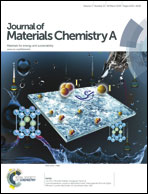Nitrogen-rich porous carbon derived from biomass as a high performance anode material for lithium ion batteries†
Abstract
Nitrogen-rich porous carbon derived from ox horns has been successfully synthesized through an economically viable and an environmentally benign approach. Such an ox horn derived carbon (OHC) possesses a large surface area (BET surface area is 1300 m2 g−1), a unique 3D porous nanostructure and a high inherent nitrogen content (5.5%). The OHC, as an anode material for lithium ion batteries (LIBs), exhibits superior electrochemical performances, such as a high reversible capacity (1181 mA h g−1 at a current density of 100 mA g−1) and a superior rate capability (304 mA h g−1 at 5 A g−1). Furthermore, this study demonstrates the exploitation of a universal material in nature, viz., ox horn, as a potential anode for the most sought after energy storage application.


 Please wait while we load your content...
Please wait while we load your content...